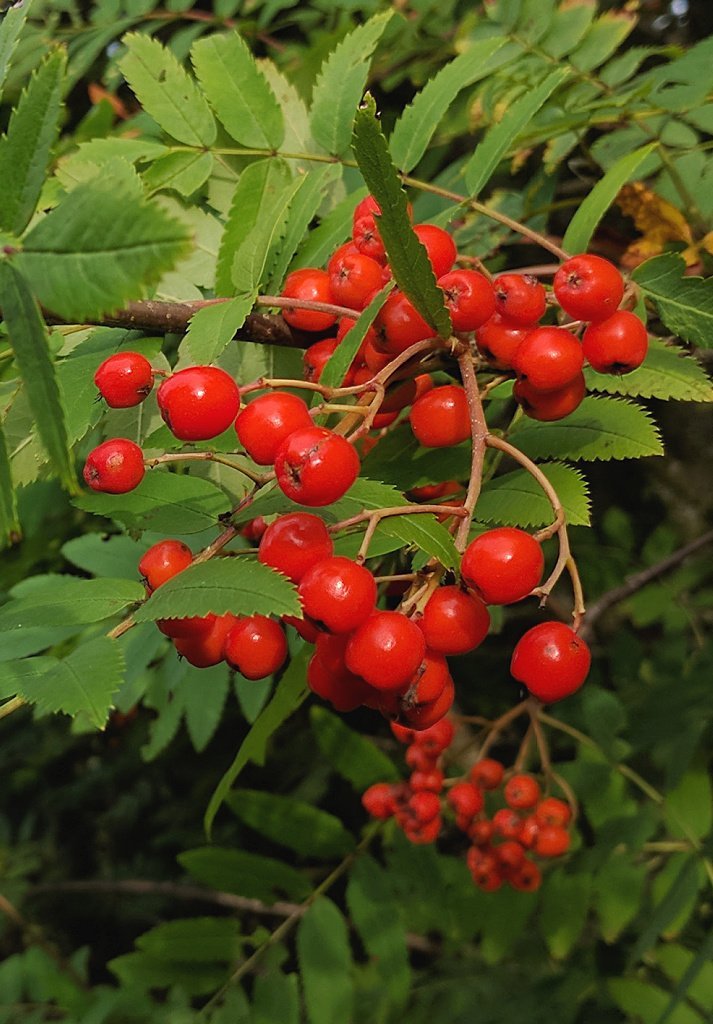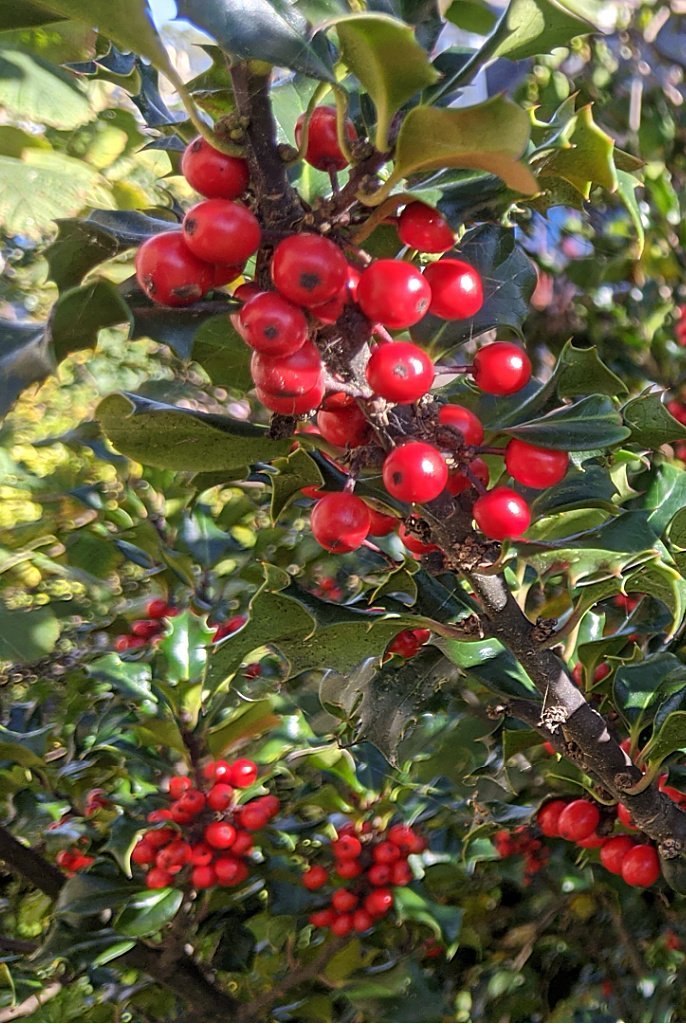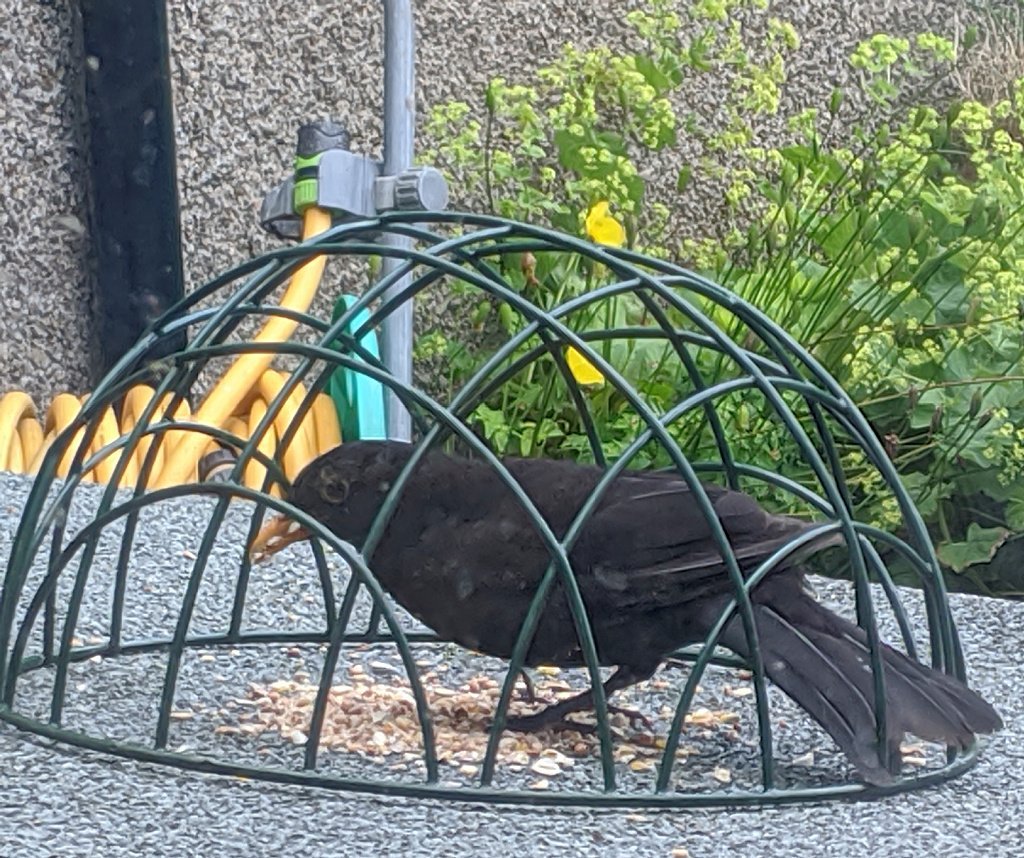Autumn colour and bird high-energy snack
Browsing through your local plant store, looking for some plants to produce berries for the garden, you arrive at the shrub section and many labels say ‘attractive berries’. Hah. What the label never says after that is ‘Birds will scoff ‘em’.
What is pleasant to the gardener’s eye is also lunch to your nearest blackbird. Bless their wee feathers.

With autumn’s arrival the birds get even bolder. Word soon gets around that the elder tree has produced a vintage crop this year. I sometimes wonder if it isn’t the blackbird equivalent of nouveau Beaujolais, that strange annual ritual of yesteryear.
Blackbirds seem to come from miles around and perform acrobatics on spindly stalks while stripping off the handsome purple panicles of berries. I’m sure they get a bit tipsy on all that juice.
This on-going meals service starts in August, usually at the top of every rowan – at least the ‘everyday’ red berried sort. The berries don’t last long – no sooner ripe than guzzled by the thrush tribe.
A tribe of thrushes
It’s good entertainment as well. Last week the local guzzlers were sent packing by a solitary fieldfare, a Scandinavian thrush visitor passing through like a burly Viking. This big grey and brown chap took over the elder tree for the morning, perhaps to refuel after his hop across the North Sea, and certainly ruffled a few of the local feathers.

(Above) The rusty-red patch under the wing is obvious and gives the redwing its name – though the yellow eye-stripe – giving a decidedly supercilious expression – is also characteristic.
Usually the fieldfares are mixed in with their slightly daintier cousins, redwings – so called because they have red oxters, though in my experience you are more likely to get a redwing in your edge-of-town garden than a fieldfare.
So if you fancy some autumn entertainment, make sure you’ve got plenty of shrubs and trees to produce berries for the garden. (In the long run, it’s a lot cheaper then feeding the birds peanuts!)
Rowan and hawthorn I’ve mentioned as native species, though you can always choose one of the other rowan species with berries in yellow (Sorbus ‘Joseph Rock’), or white (S. hupehensis).
Some say that the blackbirds are a little suspicious of these ‘non-red’ berries and tend to leave them till they’ve stripped out everything else!

Rose hips create another splash of red long after the flowers have gone and likewise survive much later in the season before being eaten (at least in my garden).
The native dog rose, common in hedgerows, provides some colour, or you can go in for, say, the big flask-shaped hips of Rosa moyesii, if you have space for this vigorous shrub.
Hollies, too, seem to keep their berries longer than some other shrubs and trees. Maybe the consumers find the spines a bit of a problem. This is just as well, if you want Christmas decorations.

Holly? It’s complicated
If the variegated kinds of holly take your fancy, like ‘Golden King’ or ‘Golden Queen’, then don’t assume that the queen variety is female and a berry producer. It isn’t. Don’t ask me why.
However, the most common silver holly ‘Argentea Marginata’ must be, as it usually has plenty of berries.
Pyracantha, the firethorn is another fairly reliable berrying species, with both red and orange berried varieties. It’s definitely a blackbird preference. (And it’s pretty thorny, so that puts paid to my holly theory above.)
And one of my favourites, for its sheer toughness in the face of sea winds, is sea buckthorn. You will need male and female plants to produce berries, which are bright orange, soft and squishy, with a decidedly jammy smell even while still on the shrub. To our palates though, the smell and taste don’t match. Trust me, these orange berries are very bitter!

(Above) Look, I can explain this. This isn’t as bad as it looks The upturned hanging basket is a feeble attempt to keep out my local severely obese wood-pigeon but let the wee birds in. I thought Mr Blackbird would have difficulty but it didn’t bother him. He just ignored it. In and out – no bother.
Obviously not to our northern winter visitors from the thrush tribe: fieldfares and redwings go daft for them.
If you live in East Lothian, you’ll have seen them every year feasting on the silvery buckthorn bushes in the thickets along the coast from Longniddry down to the Scottish Borders at Cockburnspath.
If reds and oranges are a bit bright, try the blues. Mahonias will produce funny wee blackish-blue fruits in summer which last about five minutes before a passing blackbird stops for a quick lunch.
A couple more berry suggestions
Also in a blue, Viburnum davidii will also ring the changes in the local blackbirds’ menu, but to get berries you have to be good at sexing viburnums when buying them, as you need one of each. It isn’t a skill that everyone develops.

And, of course, it’s a two-way thing. Blackbirds eat the slugs that eat our lettuce. (Have you noticed the way they fastidiously wipe them on the grass first? The slugs, I mean.)
Song thrushes dunt the life out of snails, whacking them on the paving slabs – though the song thrush, as a species, is much more prone to cat predation. (Don’t get me started…)
Ultimately, growing species that produce berries for the garden to feed the birds seems a worthwhile use of your wee plot. There’s a ‘feel-good’ thing going on – especially in a built-up world that embraces ‘lockblock’ and plastic grass and we slide towards the urban desert…

